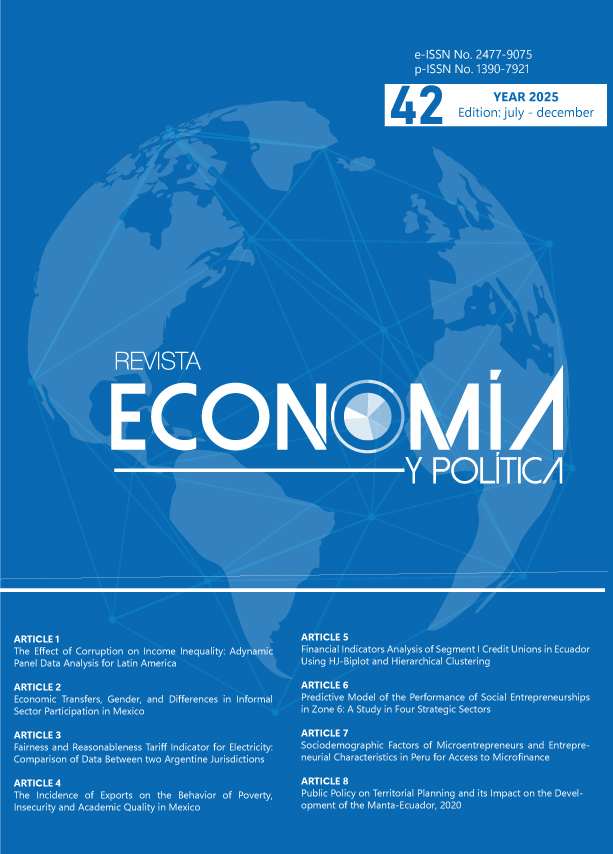Financial Indicators Analysis of Segment I Credit Unions in Ecuador Using HJ-Biplot and Hierarchical Clustering
DOI:
https://doi.org/10.25097/rep.n42.2025.05Keywords:
savings and credit cooperatives, financial indicators, economic growth, hj-biplot, hierarchical clustering, MinskyAbstract
This study examines the applicability of Hyman Minsky’s Financial Instability Hypothesis (FIH) within Ecuador’s Tier I savings and credit cooperatives, focusing on their capital structure, operational efficiency, and asset quality. According to the FIH, periods of financial stability encourage riskier financial behavior, ultimately weakening capital buffers and increasing systemic fragility. Using HJ-Biplot analysis and cluster techniques, the study identifies three distinct stages of financial fragility among the cooperatives. The findings reveal that institutions with strong capital adequacy exhibit greater stability, while those with high levels of delinquency and non-performing assets are more likely to shift toward speculative or speculative financial strategies. Some cooperatives have adopted restructuring measures to mitigate risk, though their effectiveness may be limited in the face of prolonged crises. Overall, the results provide empirical support for the FIH, underscoring the influence of microeconomic decision-making on institutional financial stability.
Downloads
References
Banco Central del Ecuador. (2022). Estabilidad financiera en el Ecuador: Propuesta conceptual. Apuntes de Economía, (70). https://contenido.bce.fin.ec/documentos/PublicacionesNotas/Catalogo/Apuntes/ae70.pdf
Barrett, A. B. (2018). Stability of zero-growth economics analysed with a Minskyan model. Ecological Economics, 146, 228-239. https://doi.org/10.1016/j.ecolecon.2017.10.014
Charles, S. (2024). Does the Eurozone live in a Minskyan world? Research in Economics, 78(4), 100984. https://doi.org/10.1016/j.rie.2024.100984
Gabriel, K. R. (1971). The biplot graphic display of matrices with application to principal component analysis. Biometrika, 58(3), 453-467. https://doi.org/10.1093/biomet/58.3.453
Galindo, M. P. (1988). Una alternativa de representación simultánea: HJ-Biplot (An alternative of simultaneous representation: HJ-Biplot). Questíio, 10, 13–23.
Golo, N., Bree, D. S., Kelman, G., Usher, L., Lamieri, M., & Solomon, S. (2016). Too dynamic to fail. Empirical support for an autocatalytic model of Minsky’s financial instability hypothesis. Journal of Economic Interaction and Coordination, 11(2), 247-271. https://doi.org/10.1007/s11403-015-0163-7
Junta de Política y Resolución Financiera. (2024). Resolución Nro. JPRF-F-2024-0129. https://jprf.gob.ec/wp-content/uploads/2024/12/4._resolucion_no._jprf-f-2024-0129_firmada.pdf
Lahart, J. (2007, agosto 18). In time of tumult, obscure economist gains currency. Wall Street Journal. https://www.wsj.com/articles/SB118736585456901047
Lavoie, M. (2014). Post-Keynesian economics: New foundations. Edward Elgar Publishing Ltd.
Levy-Orlik, N. (2010). Minsky’s financial instability hypothesis in the new financial institutional framework: What are the lessons for developing countries? En D. Tavasci & J. Toporowski (Eds.), Minsky, crisis and development (pp. 155-167). Palgrave Macmillan UK. https://doi.org/10.1057/9780230292321_10
Minsky, H. P. (1986). Stabilizing an unstable economy. Yale University Press. http://archive.org/details/stabilizingunsta0000mins
Superintendencia de Economía Popular y Solidaria. (2017). Nota técnica de fichas metodológicas de indicadores financieros. https://estadisticas.seps.gob.ec/wp-content/uploads/2022/02/Nota-tecnica-indicadores-financieros-v1.0.pdf
Phan, L. N., Beruvides, M. G., & Tercero-Gómez, V. G. (2024). Statistical analysis of Minsky’s financial instability hypothesis for the 1945–2023 era. Journal of Risk and Financial Management, 17(1), 32. https://doi.org/10.3390/jrfm17010032
Solomon, S., & Golo, N. (2013). Minsky financial instability, interscale feedback, percolation and Marshall–Walras disequilibrium. Accounting, Economics and Law, 3(3), 167-260. https://doi.org/10.1515/ael-2013-0029
Published
How to Cite
Issue
Section
License
Copyright (c) 2025 Economy and Politics Journal

This work is licensed under a Creative Commons Attribution-NonCommercial-ShareAlike 4.0 International License.
The Journal declines any responsibility for possible conflicts derived from the authorship of the works that are published in it.
The University of Cuenca in Ecuador conserves the patrimonial rights (copyright) of the published works and will favor the reuse of the same ones, these can be: copy, use, diffuse, transmit and expose publicly.
Unless otherwise indicated, all contents of the electronic edition are distributed under a Creative Commons Attribution-NonCommercial-ShareAlike 4.0 International License.






